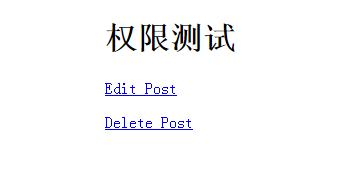本文實例講述了Laravel5.1框架自帶權限控制系統 ACL用法。分享給大家供大家參考,具體如下:
Laravel在5.1.11版本中加入了Authorization,可以讓用戶自定義權限,今天分享一種定義權限系統的方法。
1. 創建角色與權限表
使用命令行創建角色與權限表:
|
1
|
php artisan make:migration create_permissions_and_roles --create=permissions |
之后打開剛剛創建的文件,填入下面的代碼:
|
1
2
3
4
5
6
7
8
9
10
11
12
13
14
15
16
17
18
19
20
21
22
23
24
25
26
27
28
29
30
31
32
33
34
35
36
37
38
39
40
41
42
43
44
45
46
47
48
49
50
|
public function up(){Schema::create('roles', function (Blueprint $table) {$table->increments('id');$table->string('name');$table->string('label');$table->string('description')->nullable();$table->timestamps();});Schema::create('permissions', function (Blueprint $table) {$table->increments('id');$table->string('name');$table->string('label');$table->string('description')->nullable();$table->timestamps();});Schema::create('permission_role', function (Blueprint $table) {$table->integer('permission_id')->unsigned();$table->integer('role_id')->unsigned();$table->foreign('permission_id')->references('id')->on('permissions')->onDelete('cascade');$table->foreign('role_id')->references('id')->on('roles')->onDelete('cascade');$table->primary(['permission_id', 'role_id']);});Schema::create('role_user', function (Blueprint $table) {$table->integer('user_id')->unsigned();$table->integer('role_id')->unsigned();$table->foreign('role_id')->references('id')->on('roles')->onDelete('cascade');$table->foreign('user_id')->references('id')->on('users')->onDelete('cascade');$table->primary(['role_id', 'user_id']);});}public function down(){Schema::drop('roles');Schema::drop('permissions');Schema::drop('permission_role');Schema::drop('role_user');} |
上面的代碼會創建角色表、權限表、角色與權限的中間表以及角色與用戶的中間表。
2. 創建模型
接下來使用命令行分別創建角色與權限模型:
|
1
2
|
php artisan make:model Permissionphp artisan make:model Role |
然后分別打開Permission.php、Role.php 以及 User.php ,加入下面的代碼:
|
1
2
3
4
5
|
// Permissions.phppublic function roles(){return $this->belongsToMany(Role::class);} |
|
1
2
3
4
5
6
7
8
9
10
|
// Role.phppublic function permissions(){return $this->belongsToMany(Permission::class);}//給角色添加權限public function givePermissionTo($permission){return $this->permissions()->save($permission);} |
|
1
2
3
4
5
6
7
8
9
10
11
12
13
14
15
16
17
18
19
20
21
22
23
24
25
|
// User.phppublic function roles(){return $this->belongsToMany(Role::class);}// 判斷用戶是否具有某個角色public function hasRole($role){if (is_string($role)) {return $this->roles->contains('name', $role);}return !! $role->intersect($this->roles)->count();}// 判斷用戶是否具有某權限public function hasPermission($permission){return $this->hasRole($permission->roles);}// 給用戶分配角色public function assignRole($role){return $this->roles()->save(Role::whereName($role)->firstOrFail());} |
上面的代碼實現了給角色分配權限及給用戶分配角色,然后還提供了判斷用戶是否具有某角色及某權限的方法。
之后就給使用Laravel提供的Authorization來定義權限控制了,打開 /app/Providers/AuthServiceProvider.php 文件,在 boot() 中添加代碼:
|
1
2
3
4
5
6
7
8
9
10
|
public function boot(GateContract $gate){parent::registerPolicies($gate);$permissions = \App\Permission::with('roles')->get();foreach ($permissions as $permission) {$gate->define($permission->name, function($user) use ($permission) {return $user->hasPermission($permission);});}} |
通過上面的方法就定義好了各個權限。下面就該填充數據了。
3. 填充數據
為方便起見,這里使用 tinker 命令行工具來添加幾條測試數據:
|
1
|
php artisan tinker |
之后進入命令行,依次輸入下列命令:
|
1
2
3
4
5
6
7
8
9
10
11
12
13
14
15
16
17
18
19
20
21
22
23
24
25
26
27
28
29
30
|
// 改變命名空間位置,避免下面每次都要輸入 Appnamespace App// 創建權限$permission_edit = new Permission$permission_edit->name = 'edit-post'$permission_edit->label = 'Can edit post'$permission_edit->save()$permission_delete = new Permission$permission_delete->name = 'delete-post'$permission_delete->label = 'Can delete post'$permission_delete->save()// 創建角色$role_editor = new Role$role_editor->name = 'editor';$role_editor->label = 'The editor of the site';$role_editor->save()$role_editor->givePermissionTo($permission_edit)$role_admin = new Role$role_admin->name = 'admin';$role_admin->label = 'The admin of the site';$role_admin->save()// 給角色分配權限$role_admin->givePermissionTo($permission_edit)$role_admin->givePermissionTo($permission_delete)// 創建用戶$editor = factory(User::class)->create()// 給用戶分配角色$editor->assignRole($role_editor->name)$admin = factory(User::class)->create()$admin->assignRole($role_admin->name) |
上面我們創建了兩個權限:edit-post 和 delete-post,然后創建了 editor 和 admin 兩個角色,editor 角色擁有 edit-post 的權限,而 admin 兩個權限都有。之后生成了兩個用戶,分別給他們分配了 editor 和 admin 的角色,即:ID 1 用戶擁有 editor 角色,因此只有 edit-post 權限,而 ID 2 用戶擁有 admin 角色,因此具有 edit-post 和 delete-post 權限。下面我們來驗證下是否正確。
打開 routes.php 文件:
|
1
2
3
4
|
Route::get('/', function () {$user = Auth::loginUsingId(1);return view('welcome');}) |
上面我們先驗證 ID 1 用戶的權限,然后修改 /resources/views/welcome.blade.php 文件:
|
1
2
3
4
5
6
7
8
9
10
11
12
13
14
15
16
17
18
19
|
<!DOCTYPE html><html><head><title>Laravel</title></head><body><h1>權限測試</h1><p>@can('edit-post')<a href="#" rel="external nofollow" rel="external nofollow" >Edit Post</a>@endcan</p><p>@can('delete-post')<a href="#" rel="external nofollow" rel="external nofollow" >Delete Post</a>@endcan</p></body></html> |
在視圖中我們通過 Laravel 提供的 @can 方法來判斷用戶是否具有某權限。
打開瀏覽器,訪問上面定義的路由,可以看到視圖中只出現了 Edit Post 鏈接。之后我們修改路由中用戶ID為 2 ,然后再次刷新瀏覽器,可以看到,這次同時出現了 Edit Post 和 Delete Post 兩個鏈接,說明我們定義的權限控制起作用了。

希望本文所述對大家基于Laravel框架的PHP程序設計有所幫助。
原文鏈接:https://blog.csdn.net/luyaran/article/details/53539022














